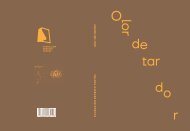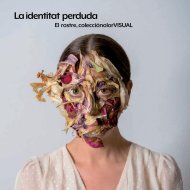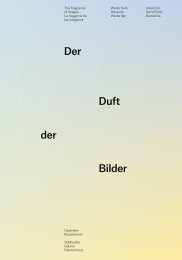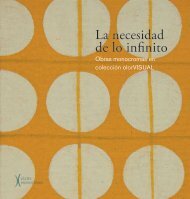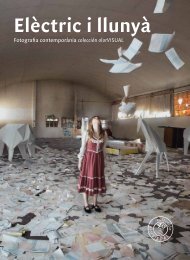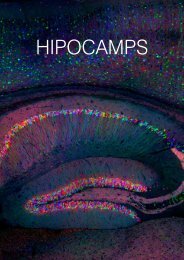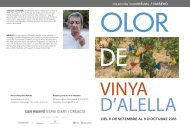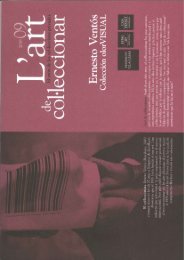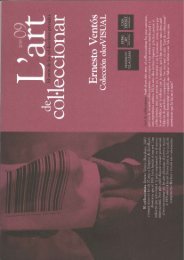You also want an ePaper? Increase the reach of your titles
YUMPU automatically turns print PDFs into web optimized ePapers that Google loves.
I am reminded of the stories by Maurice Blanchot which disorient us in their<br />
variability because they harbour a non-fictitious time, the time of the experience<br />
of the conformation of shapes veering towards the unknown. They are forms<br />
that vibrate, material resonances that smell, just like the geometry of Equipo 57<br />
or Mark Francis’s dance to chaotic rhythms. Because even when it seems to have<br />
stopped, time is experienced here. In Blanchot it is the time of the unheard-of,<br />
or the darkness or, more specifically, the absence of time or the present without<br />
presence. Hence the disturbing quality to the oil on burnt canvas by Bianca<br />
Beck. The artist is speaking to us about birth, silence, tears, a flower that opens<br />
and gives off scent, an ardent love. Fire and desire. Just like the oil painting on<br />
wood by Anne-Lise Coste. Everything accumulates, concentrates, spills over.<br />
The artists try to project a reality based on small densities, like the condensed<br />
memory of Fernando Prats, or the smoke that concentrates the navel of the<br />
world according to Eulàlia Valldosera.<br />
Meantime, night falls and the landscape changes its face. The darkness<br />
devours colours and the visible is hidden in the forest. The work by Claudia<br />
Terstappen smells of the night. The denizens of the night develop the acuteness<br />
of a nocturnal animal. At night we open ourselves to the unknown, to extreme<br />
violence. Light constructs reality and freezes places, as in the video Inercia by<br />
Carlos Irijalba. The boulevard becomes a bustle of vagabonds, as claimed by<br />
Lamazares’ painting. The main character in the work by Bernardí Roig enters<br />
the light like someone revealing a confession and encounters the divine. Our<br />
face burns, like the characters by Douglas Gordon. With no nose and no eyes,<br />
the fire snuffs out our senses. Like a road to destruction. The image, just like life,<br />
is suspended, interrupted. And so we have reached the statues of our ancestors,<br />
the outcome of an involuntary beauty that resembles the supposed aggression of<br />
the pyromaniac. Works like those by Douglas Gordon and Valentín Vallhonrat<br />
make us think about the beauty of the body eaten away by time in classical<br />
sculpture. We love them in their broken beauty. We do not try to remember or<br />
imagine the colour of so many polychromatic statues which have reached us.<br />
An attractive abyss, that of the ruin of things, that of beauty decapitated by<br />
iconoclastic acts, as Marguerite Yourcenar wrote.<br />
The same holds true with the journey of darkness. The forest passage<br />
recounted by Jünger, the ambush, is a march towards death. Darkness in this<br />
sense is a kind of ending whose culmination is this fate. Irijalba and Lamazares<br />
tell about the passion of transit. But Jünger’s forest talks to us about the<br />
impossibility of going further, of shipwreck and darkness. It is no surprise that<br />
the subject is thus revealed as a fragment in the case of Douglas Gordon, or as the<br />
corrosion of the cadaverous body in Enrique Marty.<br />
Almost one decade ago the person who wrote this sent Bernardí Roig a<br />
letter to be read blindly. The artist had confessed to being afraid of the lack<br />
of answers. Naturally, he was talking about life, but he was especially talking<br />
about that shadow with an expiring passport which is death. Although he was<br />
surely talking more about hope, that sort of antechamber. It is difficult for me to<br />
imagine his characters going directly from one place to the other. In any event,<br />
they find meaning in beating around the bush, like Lamazares’ vagabonds or<br />
Irijalba when he manages to turn reality into a representation of itself.<br />
At night, nothing is projected more than the light and smell of death. Enrique<br />
Marty offers a sculpture which depicts a putrefied body found in a marshy<br />
area very close to the water. The bodies that remain in this wet state, with<br />
their entrails exposed, take on the qualities of the land, begin to mimic it and<br />
give off a very particular odour. The same is true of Barceló’s still life, which<br />
shows a suspended corporality, a bronze skewer that smells dry. Depicting the<br />
134




